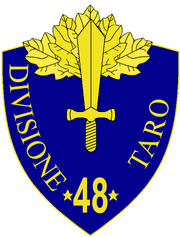48th Infantry Division Taro
| 48th Infantry Division Taro | |
|---|---|
|
48th Infantry Division Taro Insignia | |
| Active | 1939–1943 |
| Country | Italy |
| Branch | Italian Army |
| Type | Infantry |
| Size | Division |
| Nickname(s) | Taro |
| Engagements | World War II |
| Commanders | |
| Notable commanders | General General Gino Pedrazzoli[1] |
The 48th Infantry Division Taro was an infantry division of the Italian Army during World War II. It was formed 12 September 1939 in Catanzaro and ceased to function in Toulon 8 September 1943.
Actions
The Taro division was deployed in Civitavecchia by 10 June 1940 and seen no action during Italian invasion of France. 19 November 1940, it was ordered to transfer to Albania via Bari, as part of Italian II Corps. First units have started to disembark in Durrës 27 November 1940. By 30 November 1940, the disembarkation was complete. By 1 December 1940, the 207th regiment of Bari was reinforcing 19th Infantry Division Venezia near Pogradec, while 208th regiment was reinforcing 53rd Infantry Division Arezzo. At the same time, division headquarters with some other units temporarily assigned from the broken Italian formations, were organizing defences at Shkumbin river valley.[2] By 11 December 1940, the Taro division comprised 208th and 225th infantry regiments together with 48th artillery regiment, have made a stand at Guri i Llengës - Shkumbin line. The defensive line was never broken, although the pressure from Greek units was mounting up in January - February 1941, resulting in some positions near Guri i Llengës been overrun but soon re-captured 14 February 1941. The last major attack from the Greek come 20 February 1941, and 6 March 1941, the Taro was on the offensive, capturing Guri i Topit and other peaks by 8 March 1941. Afterwards, the division remained in the same positions during the entire Battle of Greece until 23 April 1941.
In June, 1941, the Taro was transferred to Montenegro, quartering in Cetinje, Bar, Nikšić and Danilovgrad. 19 July 1941, an additional garrison was established in Kotor. In the 1942 the division have conducted an anti-partisan raids at Budva, Velja Gora, Boguti and Čisto Polje. In February–March 1942, an especially large group of Yugoslav Partisans was beaten off at Bokovo. In August, 1942, the division was called back to Italy, quartering in Alessandria-Novi Ligure area. In November 1942, the Taro have participated in Case Anton, occupying Vichy France area north of Toulon and on the coastal strip to the east, from Cape Brun to Cavalaire-sur-Mer. It quartered in Cuers, Méounes-lès-Montrieux, Pierrefeu-du-Var and Carnoules.[3]
Orders of battle
Order of battle (1940)
- 207. Taro Infantry Regiment
- 208. Taro Infantry Regiment
- 48. Artillery Regiment
- 164. CCNN Legion
- 48. Mortar Battalion (da 81)
- 48. Anti-Tank Company (47/32
- 48. Mixed telegraph/radio Signal Company
- 11. Pioneer Company
- 48. Searchlight Section
- 58. Medical Section
- 222. Field Hospital
- 237. Field Hospital
- 368. Heavy Motor Transport Section
- 58. Supply Section
- 23. Mixed Carabinieri Section
Order of battle (1943)
- 207. Taro Infantry Regiment
- 208. Taro Infantry Regiment
- 48. Artillery Regiment
- 1. Artillery group
- 2. Artillery group
- 3. Artillery group
- 48. Mortar Battalion (da 81)
- 48. Engineer Battalion
- 168. Coastal defence regiment
Notes
- Footnotes
- ↑ An Italian Infantry Division normally consisted of two Infantry Regiments (three Battalions each), an Artillery Regiment, a Mortar Battalion (two companies), an Anti Tank Company, a Blackshirt Legion of two Battalions was sometimes attached. Each Division had only about 7,000 men, The Infantry and Artillery Regiments contained 1,650 men, the Blackshirt Legion 1,200, each company 150 men.[4]
- Citations
- ↑ Enrico Tagliazucchi and Franco Agostini. "Royal Italian Army". Archived from the original on 4 April 2009. Retrieved 2009-04-29.
- ↑ http://www.regioesercito.it/reparti/fanteria/rediv48.htm
- 1 2 Marcus Wendal. "Italian Army". Axis History. Retrieved 2009-04-28.
- ↑ Paoletti, p 170
- Paoletti, Ciro (2008). A Military History of Italy. Greenwood Publishing Group. ISBN 0-275-98505-9.
